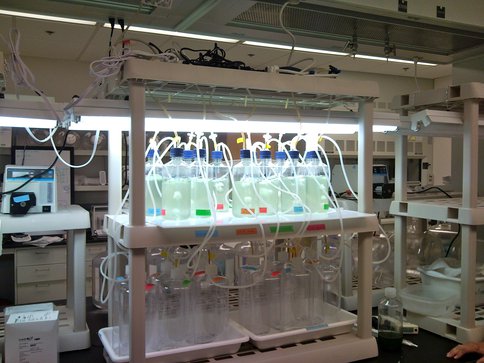2009 Annual Science Report
 Arizona State University
Reporting | JUL 2008 – AUG 2009
Arizona State University
Reporting | JUL 2008 – AUG 2009
Stoichiometry of Life, Task 1: Laboratory Studies in Biological Stoichiometry
Project Summary
Living things require a broad menu of chemical elements to function. This project aims to quantify the chemical elements required by prokaryotes – the class of terrestrial organisms thought most similar to those that might be present in extraterrestrial settings – through laboratory experiments. These experiments will also teach us the ways in which such organisms cope with scarcity of the bioessential elements nitrogen, phosphorus and iron. We are also conducting experiments to isolate micro-organisms that use the element arsenic in place of phosphorus, if they exist. In Year 1 we initiated the first stage of these experiments.
Project Progress
During the past six months we have been developing the apparatus, media, and approaches for our first proposed nutrient limitation study using Synechocystis sp. PCC 6803. We have designed the chemostat vessels and the lighting and pumping systems. We worked to modify the standard BG11 medium for our purposes but discovered that unacceptable precipitates were forming when autoclaved. We assayed the maximum growth rate (um) of the Synechocystis sp. PCC 6803 for the lab conditions. We successfully switched to modifications of “COMBO” medium that is used extensively in Elser’s lab. Chemostats are now equilibrating to three growth rates (90%, 50%, and 10% of um) and we expect to complete the comprehensive metabolic, genomic, biochemical, and stoichiometric measurements within the next month. We have also worked to develop the assay methods we will use when the cultures are ready, including methods of macromolecular quantification and metabolic performance (oxygen production and consumption).
In subtask A “Element limitation and autotrophic C export”, co-PI Susanne Neuer and students have begun studies to investigate extracellular polysaccharide (EPS) production and characterization of the model cyanobacterium Synechococcus sp. WH 8102 under N-, P-, or Fe-limitation. Preliminary experiments have shown aggregate formation in the late exponential stage in batch cultures. We have also begun to develop axenic chemostat cultures of the Synechoccus and are working on protocols for the quantitative analysis of EPS.
In subtask B “Alternative life”, collaborator Felisa Wolfe-Simon (with additional support from a NASA NAI DDF award) has pursued studies related to the possibility of arsenate-based life forms. Field collection of samples and preliminary experiments have generated data suggesting a novel use of arsenic in the high salinity, elevated pH and arsenic-enriched waters of Mono Lake (CA). Thus far we have see slow but steady growth and increased turbidity in aerobic enrichment cultures without added phosphate but including up to 5mM arsenate and 10 mM glucose, cultivated for many generations over >2 months. Microbial populations present have been verified by microscopy and plating.
Figure 1. Chemostats. Dedicated chemostats were designed and built for this project. The growth rate and conditions in each bottle can be adjusted by varying the composition of the growth media and the rate at which fresh media is introduced. (Photo credit: A. D. Anbar)
Publications
-
Wolfe-Simon, F., Davies, P. C. W., & Anbar, A. D. (2009). Did nature also choose arsenic?. Int.Jnl Astrobiol., 8(02), 69. doi:10.1017/s1473550408004394
-
-
PROJECT INVESTIGATORS:
-
PROJECT MEMBERS:
Ariel Anbar
Co-Investigator
Susanne Neuer
Co-Investigator
Felisa Wolfe-Simon
Collaborator
Amisha Poret-Peterson
Postdoc
Marcia Kyle
Research Staff
Jennifer Glass
Graduate Student
Amy Hansen
Graduate Student
Michele Knowlton
Graduate Student
Benjamin Brugman
Undergraduate Student
Zuri Martinez
Undergraduate Student
Christie Sabin
Undergraduate Student
-
RELATED OBJECTIVES:
Objective 5.1
Environment-dependent, molecular evolution in microorganisms
Objective 5.2
Co-evolution of microbial communities
Objective 5.3
Biochemical adaptation to extreme environments
Objective 6.1
Effects of environmental changes on microbial ecosystems
Objective 6.2
Adaptation and evolution of life beyond Earth
Objective 7.1
Biosignatures to be sought in Solar System materials

